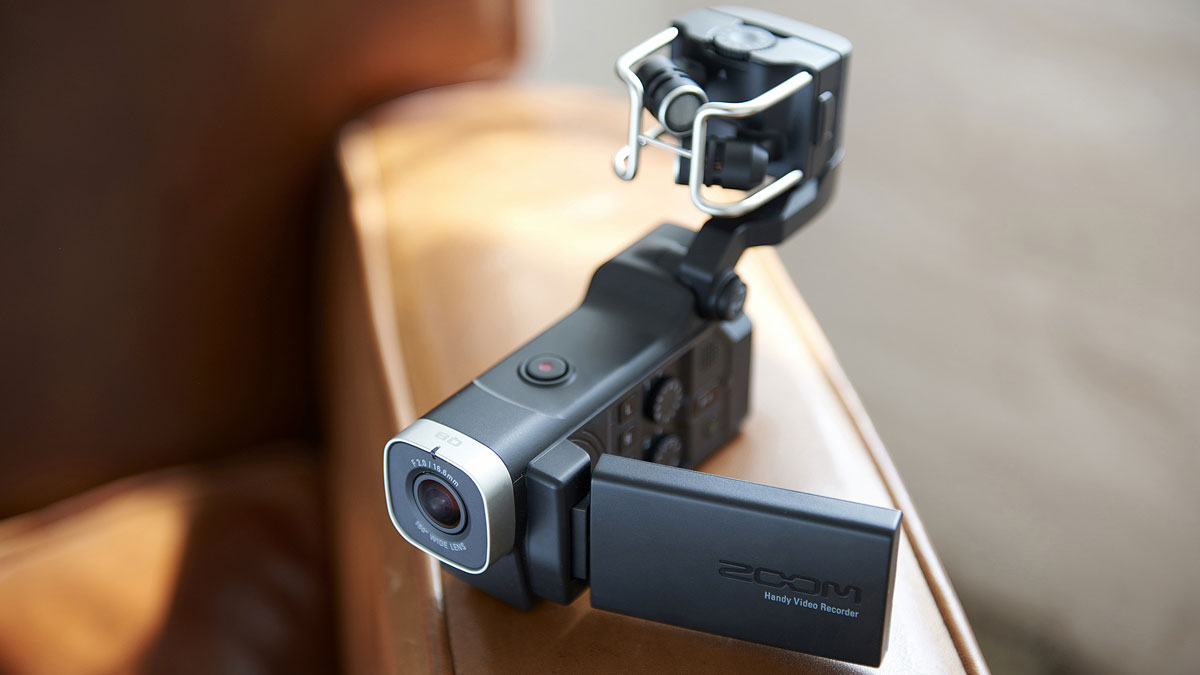MusicRadar Verdict
A practical addition to your gigbag to record both audio and visuals.
Pros
- +
Useful in a range of applications. Carefully considered controls and connections.
Cons
- -
Touchscreen can be fiddly for the large fingered.
MusicRadar's got your back
If you play in a band or are a solo artist, there are more opportunities than ever these days when it comes to self-promotion and making money from music - posting videos on YouTube, selling your music on iTunes and more. Of course, you need technology to make that happen, and the Q8 from Zoom seems to tick a lot of the relevant boxes.
It's a portable video and audio recorder that offers high-definition video and quality audio recording (up to 24-bit/96kHz), so could be a great choice for recording the visuals and music together at a gig.
"Four channels of audio can be recorded simultaneously with or without video"
Light and easily portable, the Q8 can be hand-held but lends itself to being in a fixed position on a stand courtesy of the tripod mount on its base. The unit runs off a rechargeable lithium-ion battery and records to an SD card (not supplied).
Four channels of audio can be recorded simultaneously with or without video. There's a stereo track that can be recorded using the attached X/Y mic (Zoom has an interchangeable mic capsule system with a range of other mics available), and there are a pair of XLR/jack combo inputs to take mic or line inputs for the other two tracks, which can configured as a stereo pair or separate mono tracks.
A built-in speaker and stereo headphone/line output jack take care of audio monitoring. Four different recording modes are selectable: video with audio, video with separate audio files, stereo audio, or multi-audio.
Setting up is a relatively straightforward process, using a rotatable touchscreen that also serves as your video monitor, although anyone blessed with fat, podgy fingers might initially find negotiating the menus a bit fiddly.
In Use
Once set up, recording is initiated with a press of a single red button. Physical controls are, in fact, kept to a minimum - just the necessary buttons for playback and to arm the tracks, and easily-adjusted input gain dials for the mic and the two inputs.
"It also supports live streaming and the Q8 can be used as a webcam or USB microphone"
For the video, you get a 160-degree wide-angle lens with digital zoom and a choice of formats up to 2,034 x 1,296 pixels (3M HD), with frame rates of up to 60fps at 720p. There's a HDMI output for video monitoring.
A USB connection transfers all .mov files and .wav files to your computer for editing. It also supports live streaming and allows the Q8 to be used as a webcam or USB microphone.
So, is it for you? Well, in a band you can be videoing the gig while recording the audio in the room with the mics and recording a feed from the mixing desk onto the other tracks - all time stamped and synchronised for editing later.
A solo performer could record the stereo sound in the room alongside separate tracks of acoustic guitar and vocals. There's also use as a pure audio recorder for capturing song ideas and the like. Overall, the Q8 is a creative tool that could expand your musical horizons.
Trevor Curwen has played guitar for several decades – he's also mimed it on the UK's Top of the Pops. Much of his working life, though, has been spent behind the mixing desk, during which time he has built up a solid collection of the guitars, amps and pedals needed to cover just about any studio session. He writes pedal reviews for Guitarist and has contributed to Total Guitar, MusicRadar and Future Music among others.
"This $399 item will incur over $578 in additional import charges": Price of Sonicware CyDrums drum machine more than doubles thanks to Trump tariffs
“For guitarists who crave an unrelenting, aggressive tone that stands out in any mix”: The Fortin Meshuggah head is the amp every metal player wants – now you can get its crushing tones in a pedal
“At least you know I sing live”: Lady Gaga apologises to fans as she falls victim to a mic malfunction during her second weekend set at Coachella











